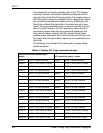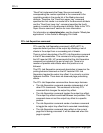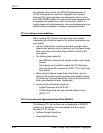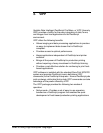
PCL 5
Guide to Using Page Description Languages 2-15
• Minimize raster usage (avoid translating fonts or lines into
raster data); on fast (100Mbit) networks, send uncompressed
data.
• Maximize use of internal scalable fonts.
• Define logos as fonts rather than raster graphics.
• Rotate rasters to align with printer edge feed, using the
Raster Graphics Presentation Mode, if possible.
• Minimize switching between HPGL and PCL modes.
• Download resources outside of macros.
PCL 5c support
This section provides specific information related to the
DocuPrint NPS/IPS implementation of PCL 5c on the 4850,
4890, 92C. For more information on PCL 5c, see the
HP PCL 5
Color Technical Reference Manual
.
The DocuPrint NPS/IPS implementation of PCL 5c is tuned for
optimal print quality on the 4850, 4890, 92C highlight color
printers.
NOTE: If the same document is printed with PostScript and with
PCL 5c, the highlight color may not match exactly.
When the DocuPrint NPS/IPS PCL 5c interpreter is installed on
the highlight color printers, the decomposer can switch between
highlight color and monochrome modes dynamically on a per-job
basis. You can specify monochrome printing (that is, Executive
Black mode) by setting the highlight color attribute to black. The
PCL 5e interpreter is used for monochrome mode.
In general, PCL 5c jobs can be expected to have much larger file
sizes than PCL 5e jobs because of the nature of the PCL 5c
driver. This is not a function of DocuPrint NPS/IPS.
The default highlight color rendering algorithm, Automatic, is not
recommended for use with PCL 5c jobs. Presentation and
Pictorial rendering algorithms produce the best appearance.
The ColorToHighlight algorithm is also supported for PCL 5c.
For PCL 5c jobs, the Thicken attribute has no effect.
User-defined dither patterns are ignored. The default highlight
color dither pattern is used instead.


















